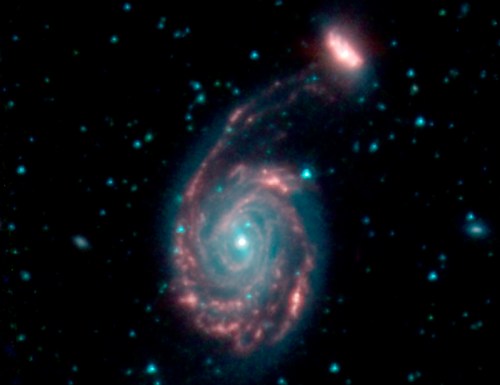
Images collected from NASA’s Spitzer Space Telescope are shedding light on the dramatic conditions that arise when two galaxies collide. Due to the strong gravity resulting from the large mass of a galaxy, galaxies are drawn together and eventually collide. Sometimes this results in one of the galaxies being annihilated, as scientists believe will happen when the Large Magellanic Cloud collides with our Milky Way in two billion years’ time. But at other times, the two galaxies merge together to create one huge galaxy.
Researchers are using the images from Spitzer to try to understand which conditions make galaxies merge and which make them destroy each other. Merging galaxies appear particularly bright to telescopes using infrared, like Spitzer, so it’s the ideal tool to collect data on this topic. During some mergers, galaxies continue to produce new stars, but more often the star formation process is halted which causes the destruction of one or both galaxies.
Most galaxies have a supermassive black hole at their center, and the latest theory is that it is the properties of this black hole that makes the difference between a smooth galactic merger and a destructive one. When a merger happens, dust and gas are pushed towards the center of each galaxy which both helps supply the material for making new stars and feeds the supermassive black hole. In some cases, if the supermassive black hole remains stable, the galaxy will continue to make new stars. In other cases, the instability of the supermassive black hole creates shockwaves which propagate out across the galaxy and push the dust and gas back out away from the center, halting star formation.
Scientists are still seeking to understand the relationship between galactic mergers, the rate of star formation, and black hole activity. One approach is to study a recently merged galaxy, as a project using the W.M. Keck Observatory in Hawaii is currently doing. Researchers there are looking for the signs of shockwaves caused by a supermassive black hole gobbling up nearby material, although they have not found any of the expected shock signatures yet. This suggests that there is more to the puzzle of galactic mergers that we still don’t understand.
Editors' Recommendations
- Astronomers spot two black holes colliding in epic merger
- Trippy NASA video shows two black holes interacting
- Six galaxies trapped in cosmic web could explain supermassive black hole growth
- Hubble images dusty galaxy to learn about supermassive black holes
- NASA’S NESSI instrument can pick out the atmospheres of distant exoplanets